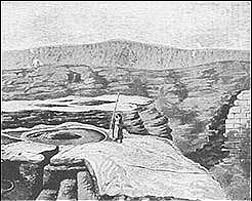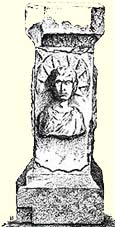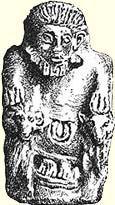| Come and Hear™ to increase interfaith understanding http://www.come-and-hear.com This page has been scanned from The Jewish Encyclopedia (1901-1906) to ensure availability for future students of Come and Hear™ |
THE JEWISH ENCYCLOPEDIA
VOL. II
Pages 378 — 381
BA‘AL AND BA‘AL-WORSHIP. — Biblical Data: The wide-spread and primitive Semitic root (“ba‘al”) may be most nearly rendered in English by “possess.” The term “Ba‘al,” therefore, which is usually explained as meaning “lord,” is properly “possessor” or “owner,” and is so used in a great variety of applications in common Hebrew speech.
 Altar of Ba‘al at Petra, Idumaea. (After a photograph.) |
 Ba‘al as a Sun-God. (From a Phenician stele in the Louvre.) |
|
Bel in |
This, however, will hardly account for the place held by Bel in the Babylonian pantheon, where he appears as the god of the earth, distinguished from Anu, the god of the heavens, and Ea, the god of the lower world. Bel seems to have been honored on similar grounds in Lagash in southern Babylonia, and it is reasonable to suppose that it was a combination of the several leading cults of such Bels that led to the unification indicated in the position of the great Babylonian Bel. It appears probable that it was the gradual assimilation of cities and petty states that raised the leading local deities to national prominence. Thereafter other influences, sacerdotal, theological, and administrative, cooperated to make a favorite cult predominant. Bel, accordingly, became a distinct national god, with a proper name, at an early date, though at a comparatively late stage of religious development.
|
Jews |
 Ba‘al Hamon. (From a Phenician terra-cotta in the Louvre.) |
To account for the worship of these Ba‘alim we may refer to the usage of the word as a common noun. The supernatural powers most obvious to the imagination of primitive Semites were those which were supposed to supply their most pressing wants, such as the need of food and drink. Gatherings and settlements were made where the soil was most inviting; that is, where it was perennially productive. Such districts were regarded as being fertilized by
[page 380] divine agency, and as each of them had its own divinity or demon as the “owner” of the soil, such a being was called its “Ba‘al.” The usage, having thus begun in agricultural settlements, was naturally transferred to the sites of cities, all of which were in any case founded under
|
Stages in |
It is not correct, therefore, to speak of Ba‘al as being a universal Semitic deity, nor even as being the object of a common Canaanitish worship. On the other hand, It can not be said that there was no god Ba‘al, as a distinct divinity among inland or maritime Canaanites, for later usage points clearly to the use of the word as a proper name without any definition whatever.
It would appear that the Hebrews first learned Ba‘al-Worship from the agricultural Canaanites. Their life before the conquest
|
How the |
 Dilling Exhibit 293 Begins |
The noxious elements in such Ba‘al-Worship were not simply the degradation of
YHWH and the enthronement in his place of a baseless superstition. The chief evil
arose from the fact that the Ba‘als were more than
Dangers
Popular
mere religious fantasies. They were made the symbols of the reproductive powers of nature, and thus
their worship ministered to sexual indulgences, which it at the same time legalized and
encouraged. Further, there was placed side by side with the Ba‘al a corresponding female symbol, the ASHTORETH (Babyl. “Ashtar”) and the relation between the two
deities was set forth as the example and the motive of
unbridled sensuality. The evil became all the worse when in the popular view YHWH himself was regarded as one of the Ba‘als
and the chief of them (Hosea ii. 16). It was in northern Israel, where agriculture was more
followed than in the southern kingdom, that Ba‘al-Worship was most insidious and virulent. The
Book of Hosea speaks eloquently and pathetically of the moral and religious ruin which it wrought in
the days just before the fall of the monarchy. It was to the
Ba‘als that the popular worship of the high places was paid; or, more frequently, to YHWH
and Evils
of the
Worship.
Himself with Ba‘alish rites. In the kingdom of Judah the inveterate evil was abated, if
not at once quelled, by the concentration of all religious acts in Jerusalem and its Temple. More
pernicious while it lasted than this popular inland Canaanitic cult was the elaborate official Ba‘al-Worship of Ahab and Jezebel,
above alluded to, which was finally rooted out by revolution and proscription (II Kings ix,
x.). It had prophets by the hundred, as well as priests, and
had the effect of virtually though not avowedly putting the religion of YHWH under
the ban. It was introduced into Judah by Athaliah, daughter of Jezebel; and its suppression
there was also accompanied by a civil outbreak (II Kings xi. 4 et seq.). Ba‘al-Worship did not play so great a part in the
later religion of Judah as did the adoration of the heavenly
bodies and related usages borrowed from Assyria and Babylonia. Yet the customs native to the
soil lingered on till they were obliterated by the Exile.
and Official
Forms of
the Cult.
Apart from the offerings of fruits from the earth and the firstlings of cattle, much is not known with regard to the rites of the popular Ba‘al Worship.
|
Rites and |
|
Ba‘al in |
BIBLIOGRAPHY: Selden, De Dis Syris; Movers, Phoenizier, i.169 et seq.; Muenter, Religion der Karthager; Gesenius, Thesaurus, s.v.; Comm. ad Jes. Ii. 335 et seq.; Oort, Worship of Baalim in Israel (transl. by Colenso, 1865); Baethgen, Beitrage zur Semit. Religionsgeschichte; Bandissin, art. Baal in Herzogs Real-Encycl. 3d ed.; Nowack, Hebr. Archaeologie, ii. 301 et seq.; Benzinger. Hebr. Arch. pp.371 et seq.; Smend, Alttest. Religionsgeschichte, pp. 51 et seq., [page 381] 131 et seq.; Dillmann, Alttest. Theologie, pp. 135 et seq., 140; W. R. Smith, Religion of the Semites, 2d ed., pp. 93-113.
|
J. JR. |
J. F. McC. |
— In Mohammedan Literature: It is more than doubtful whether “Baal” appears in the Koran as a proper name. Five times it is used in the sense “husband”; once in the singular (sura xi. 75), and four times in the plural (suras ii. 228, xxiv. 31). Once it is used of a god (sura xxxvii. 125). In that passage, according to the interpretation of Ibn ‘Abhas (“Lisan al-Arab,” xiii. 62), a cousin of the prophet and the founder of Koranic exegesis (died 687), it is to be rendered “Lord.” Sura xxxvii. 128 - 127 may be translated: “And verily Elijah was one of the divine messengers when he said to his people, ‘Will ye not fear? Will ye invoke a Lord [“Ba‘1”] and abandon the best of creators, God your Lord and the Lord of your forefathers?’ But they gave him the lie; and they, verily, will be brought to judgment.” There seems little doubt that Ibn ‘Abbas’ interpretation of “Ba‘l,” as equivalent to “rabb” (lord) or “malik” (possessor), represents the conception of Mohammed. It agrees with Arabic usage (see “Lisan al-Arab,” l.c., and Lane, “Lexicon,” p. 228 b. c.). But later Islam, with few exceptions, has united to interpret “Ba’l” as a proper name. One exegete has said that it meant any idol (“sanam”) in general; another, that it was any deity except God. But for the great mass of Moslems, Ba’l was an idol of gold worshiped by the people of Bakk, a town in Syria, afterward called from it Ba’lbakk” (Baalbek). It was twenty cubits high, and had four faces; and “devils” entered it and spoke to the people from it, according to the usual Moslem idea. This was in the time of Ahab and Jezebel; and Bakk was their capital. Others have held that it was in the time of JONAH; still others, that it was a woman whom the people of Bakk worshiped. For the later legend see A1-Tha‘labi (died 1036), “Kisas al-Anbiya,” ed. Cairo, p. 142, and references above. See also ELIJAH in MOHAMMEDAN LITERATURE.
|
J. JR. |
D. B. M. |